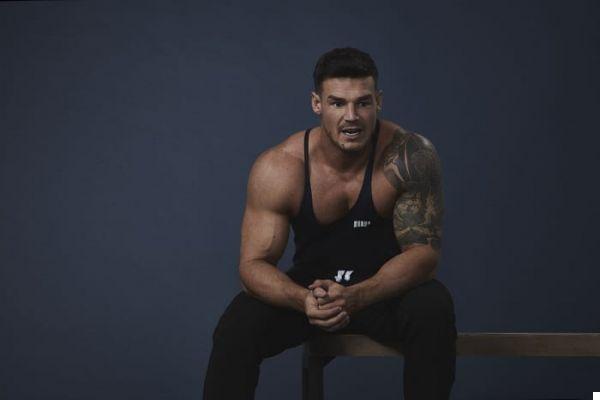By "squat machine" we mean a tool that allows you to perform the movement of the squat by reducing instability on the frontal and transverse plane.
In fact, in a free body squat it is easier to rotate the pelvis or to move more to one side; this occurs because the bar is positioned above the shoulders and the movements it can do are theoretically infinite.
Using a machine the weight is always placed on the shoulders but the machine can only move along the guide for which it is designed. The movement of resistance therefore occurs only in the sagittal plane and it is therefore easier to adhere to this movement.
In a normal squat the movement should take place only in the sagittal plane but it is necessary to perform a NON? MOVEMENT in the other planes. Preventing movement requires the activation of numerous stabilizing muscles. This aspect can have its pros and cons:
- It is useful in having a greater isolation of the kinetic chain that is established between the shoulders and the feet. This allows you to risk fewer injuries and still get the stimulation of numerous muscles by a barbell squat.
- It is counterproductive because the body is made to move in all three planes of space. If you train only in the sagittal plane, you become strong only in the sagittal plane. The body is made to function as a whole and if a link in the chain is weak, the integrity of the entire structure is affected. Performing squats on a machine does not absolutely lead to a regression of the motor patterns but does not allow to obtain the benefits that could be used instead.
Basically the squat machine is useful for two main reasons:
- Rehabilitation or post-injury or surgical reinforcement
- Employing greater loads having greater stability
The first aspect is undoubtedly useful. In a first phase of recovery, the body is subjected to an absolutely controlled and specific stress for the necessary reinforcement. Afterwards it is important to move on to a more physiological movement (as described above).

The second aspect is more questionable: using greater loads leads to muscle strengthening but without an adequate supporting connective structure the risk of injury increases.
The benefit of the squat machine is precisely that of reducing stress on the tendon and ligament component in favor of a greater contribution of the muscular one.
Often the injury factor is not the muscles but the unprepared ligaments and joints. Muscle development proceeds at a much higher speed than the connective component and not stimulating this means increasing the risk of injury.
The 5 best exercises
However, the squat machine has some useful uses. Here are the 5 best exercises and training methods:
1. Back Squat
To perform this exercise just place your feet on the lower support and place the pad on your shoulders. The body must be oriented in such a way as to bring the back towards the tool.
The distance between the feet can be perfectly adapted to your needs. A tighter stance allows for greater ROM in knee flexion and extension by recruiting more quadriceps.
A wider stance increases the work on the hip extensors. Extra rotated feet allow you to work more on the buttocks. Feet straighter forward promote greater isolation of the quadriceps.
The weight stresses many muscles of the posterior chain, first of all the trapezes are loaded in maximum elongation and must resist the high weight that pushes the shoulders down.
The lumbar muscles must work to prevent trunk flexion (they are not activated as much as in a traditional squat) and then there is the activation of the hip and knee extensor muscles.
The muscles that move the ankle are not very stressed due to the stability of the exercise.
2. Front squat
The movement is similar to the previous one but this time the torso is facing in the direction of the tool. This allows you to keep the shins relatively straight and put maximum stress on the hip flexion.
The relatively straight shinbones reduce the stress on the Anterior Cruciate Ligament and a greater excursion of the hip allows the muscles responsible for its movement to be used more.

The more vertical shins do not exclude the work of the quadriceps, it all depends on how the exercise is performed. If you focus on loading the
quadriceps in movement the work of these will be increased while if you focus on bringing the pelvis back to then have a strong extension, the hamstring and especially the buttocks work more.
The lumbar area is more exposed in relation to the ROM: in the absence of the ankle dorsiflexion, mobility is more relegated to the pelvis. It is therefore not recommended to go below 90 degrees.
This makes the front squat to the squat machine a great exercise to strengthen the vastus medialis without too much stress on the knee or to work more on the hip extensors.
Shrug
The tool can also be used to train trapezes. By placing the weight directly on the shoulders you can isolate the upper trapezes more without worrying about the strength of the grip.
In this case, as mentioned, there are the benefits of isolating a muscle more but at the expense of the work by other muscles such as those of the forearm.
Eccentric
This machine can be used to perform eccentric repetitions and therefore strengthen the connective and muscular component without too much joint stress.
Obviously we are not talking about loading the entire stack of weight but rather the weight must be adequate if not slightly less than your capacity.
Putting tension (even if this is not maximal) on the ligaments and tendons and muscles leads to their adaptation response and eliminating the concentric phase allows greater respect for these structures.
Could it be a good idea to do sets of 6? 8 repetitions with an extremely controlled negative phase of up to 10 seconds.
The tool should also allow you to check the ROM or limit the excursion to where desired. This allows you to take the weight off your shoulders. If this is not possible, it is not a good idea to perform this type of training.
Burnout
To conclude a leg workout in the best possible way, it can be a good idea to perform a series of complete exhaustion and even forced repetitions if you are a masochist. Opt for weights appropriate to your abilities and perform high repetitions.
This allows you to maximize the blood supply to the muscles of the thighs and pelvis.



























